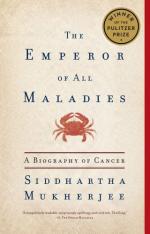|
This section contains 523 words (approx. 2 pages at 400 words per page) |

|
The Emperor of All Maladies: A Biography of Cancer Summary & Study Guide Description
The Emperor of All Maladies: A Biography of Cancer Summary & Study Guide includes comprehensive information and analysis to help you understand the book. This study guide contains the following sections:
This detailed literature summary also contains Topics for Discussion and a Free Quiz on The Emperor of All Maladies: A Biography of Cancer by Siddhartha Mukherjee.
Siddhartha Mukherjee (1970 - ) is the author of The Emperor of all Maladies: a Biography of Cancer. Mukherjee is a cancer researcher and physician who gives a brilliant and thorough examination of the history of cancer while explaining the disease in such a way that the lay person can understand its origins and the battle to treat, prevent and cure it.
Mukherjee gives objective views and historical facts about cancer in its various forms and also details all of the major discoveries in medical history and research related to finding a cure for the disease that is on its way to becoming the number one cause of death in America. He also reveals personal insights and opinions about various practices, discoveries and events.
There are times when the tone takes on a more personal bent, such as when the author describes his first encounter with Carla Reed. Mukherjee, learned about Carla after she had checked into Massachusetts General Hospital. Mukherjee was one of seven cancer fellows at the hospital involved in an immersive training program. During this time, Mukherjee began to wonder about the age of cancer. The author follows Carla's journey throughout the book, ending with the fact that she is still in remission five years after her last treatment. In the world of cancer, this is as close to a cure as one can get.
While Mukherjee is consumed with learning about the disease, he also relates that there is a personal side to it and details how it may affect various people, including the doctors and researchers invested in applying specific treatments as well as finding a cure.
Modern medicine is one of the themes in the story. The word "modern" must be applied to the stories as they are told. Some research mentioned is ancient in chronological age yet ties into "modern" treatments such as pre-screenings, preventive measures, chemotherapy, drugs, surgery, and other treatments.
Each treatment builds on what went before; however, there are many references to doctors and scientists returning to treatments and ideas used even 100 years previous when it became necessary to return to the beginning to find where some treatments and procedures had gone awry or had in some way missed the mark. As Mukherjee mentions more than once, it is necessary to go back to the genesis of the disease to find the cause when focusing on the cure seems to be unsuccessful.
The majority of the book focuses on different types of leukemia and includes its discovery, initial diagnosis and how each doctor and scientist built upon the works of those that had gone before. The book also discusses how and why many of those researchers had to go back to the beginning to try to understand cancer in order to find a cure or at least a suitable treatment.
The book is comprehensive and well-written, threading stories through medical facts. The author sums it all up well with the story of Atossa, a Persian princess who lived thousands of years ago and what her journey might have looked like if she had traveled alongside cancer up until the current time.
Read more from the Study Guide
|
This section contains 523 words (approx. 2 pages at 400 words per page) |

|



